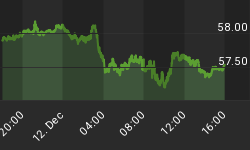12 weeks ago when the market started to climb, it was my expectation that the rally would fail and rollover prior to achieving new highs. After all, with investors expecting the Federal Reserve to come to the rescue, they weren't particularly bearish at the bottom, and in such cases, the ensuing snap back is generally weak. Well I was wrong on that account as the SP500 has notched a new cyclical high. Bulls will want to say that stocks have climbed a "wall of worry", but let's be honest that the path to the top of that wall has been on low volume and declining breadth. Nonetheless, the market has arrived at this juncture, so it must mean something bullish. Right? I don't know if I would buy such a notion, but Wall Street will do it's best to tell you so. Suddenly, analyst year end up grades are coming fast and furious. 1450, 1500 and 1550 on the S&P500. It is all good. But where were these calls 140 S&P500 points ago? Just remember what the market was telling investors at the October, 2007 market top when it hit an all time high (SP500 1576.09) and just prior to cratering over 50% in 2008. I am sure it was a similar message we are hearing this week.
While I don't want to be cataclysmic with my market analysis, I am sticking with my market call for now. The sentiment picture is still suggestive of a market top. Although the SP500 has notched new cyclical highs, I am still scratching my head as to what investors see that is so good. From this perspective, this rally started with and has continued on a poorly built foundation. The major change -aside from new cyclical highs - is that investors have chased prices higher, and that has made our measures of investor sentiment significantly more bullish, which is never a good sign.
Looking ahead, I don't believe the bullish extremes in investor sentiment that we are currently seeing will morph into one of those situations where it "takes bulls to make a bull market". In those kinds of rallies, the extremes in bullish sentiment were the start of the bullish run as opposed to the end of it. 1995, 2003, and 2009 would be good examples where too many bulls was a good thing. Those kinds of bull runs happened after prolong bearish periods, and today's environment has been anything but that.
The "Dumb Money" indicator (see figure 1) looks for extremes in the data from 4 different groups of investors who historically have been wrong on the market: 1) Investors Intelligence; 2) MarketVane; 3) American Association of Individual Investors; and 4) the put call ratio. This indicator is neutral, but just below the extremely bullish level.
Figure 1. "Dumb Money"/ weekly
Figure 2 is a weekly chart of the SP500 with the InsiderScore "entire market" value in the lower panel. From the InsiderScore weekly report: "Market-wide sentiment deteriorated last week as our main sentiment tracking metric came very close to entering negative territory. Selling was most pronounced within the S&P 500, where an Industry Sell Inflection, our strongest macro indicator of negative sentiment, triggered. The Russell 2000, meanwhile, showed Neutral sentiment."
Figure 2. InsiderScore "Entire Market" value/ weekly
Figure 3 is a weekly chart of the SP500. The indicator in the lower panel measures all the assets in the Rydex bullish oriented equity funds divided by the sum of assets in the bullish oriented equity funds plus the assets in the bearish oriented equity funds. When the indicator is green, the value is low and there is fear in the market; this is where market bottoms are forged. When the indicator is red, there is complacency in the market. There are too many bulls and this is when market advances stall. Currently, the value of the indicator is 69.70%. Values less than 50% are associated with market bottoms. Values greater than 58% are associated with market tops. It should be noted that the market topped out in 2011 with this indicator between 70% and 71%.
Figure 3. Rydex Total Bull v. Total Bear/ weekly
















